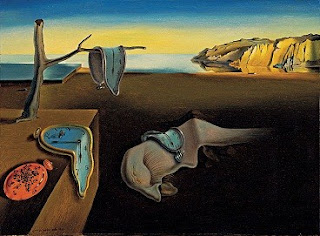 |
| The Persistence of Memory 1931 |
The Persistence of Memory by Salvador Dali in 1931
represents a surrealist perspective of deep understandings of the nature of the
universe. The painting is more than meets the eye and much deeper than its
first impression. Even though the work was started from watching melting cheese
it is also a deeply moving unconscious experience. The painter and his work
were part of a movement that delved beneath the human psyche and tried to project
that understanding for others to ponder the complex nature of human experience.
The melting watches were representations of the continuum
of space and time and the melting cosmic order. Time is relative to activity in
the environment. If everything within the environment is moving fast while the object is moving slow, time will
seeming slower than if an object speeds up and the environment lags in
speed, then time is condensed. The creature in the picture represents the
fading of images in dreams that we have a hard time formulating an
understanding of and the ants represent the eventual death of time. Wow! I bet
you didn’t expect all that!
It is possible to see the picture as an impression of Einstein’s Theory of
Relativity. All things in the universe are relative to everything else thereby creating
a cosmic order. Even though we may have thought of riding the moonbeam as pure
fantasy we soon learn in history that Einstein was correct. The universe is a
machine of order with subsequent rules and laws that govern its existence. It is possible to move faster than the moonbeam. As
with all genius, others have a hard time following their train of thought and
simply consider such inventions and works as irrational only because they are unable
to learn all of the pieces that make such far reaching constructions possible.
As Louis Aragon stated, “We know that
the nature of genius is to provide idiots with ideas twenty years later.”
The Persistence of Memory painting is part of the surrealism era of deeper
human thought. Surrealism is a revolutionary movement springing from WWI and
the 1920’s. It origin was out of Paris France and spread throughout Europe and
the United States Accordingly. The art is expected to be shocking and represent
the philosophical, social theory, and science of the era. Freud’s work of
dream interpretation and free association became a cornerstone of the movement.
The works of art were representations of realities that are perceived both
collectively and individually. Many famous artists met in coffee shops and
joined the movement because of its rich and vivid impressions.
Salvador Dali was born in 1904 and died in 1989. His
surrealist works were attributed to an influence of the Renaissance masters. Dali
was of Arab Moorish background but loved things of Western excess and luxury.
He was born in Empordà region in Spain,
which is near France, accepting both Eastern and Western traditions. He had an
interest in mathematics, natural science and infractions of light which he
incorporated into his works.
No comments:
Post a Comment